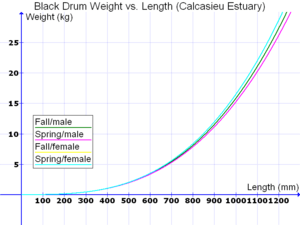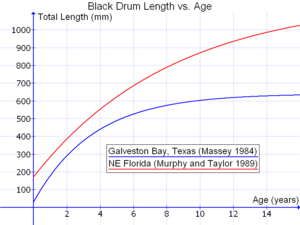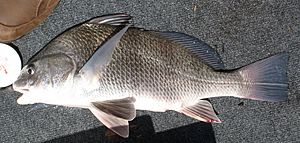Black drum facts for kids
Quick facts for kids Black drum |
|
|---|---|
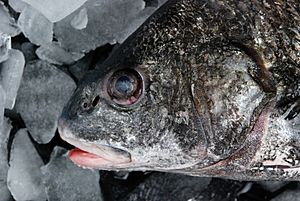 |
|
| Conservation status | |
| Scientific classification | |
| Genus: |
Pogonias
|
| Species: |
cromis
|
The black drum (Pogonias cromis) is a large saltwater fish. It's also called the drum or drummer. This fish is related to the red drum. Black drum are known for being the biggest fish in the drum family! Most black drum weigh between 5 and 30 pounds (2–14 kg). But some can grow much larger, over 90 pounds (40 kg). The biggest black drum ever caught weighed more than 113 pounds (51 kg)!
These fish are usually black or gray. Young black drum have cool dark stripes on their gray bodies. They have strong, rounded teeth and powerful jaws. This helps them crush and eat oysters and other shellfish. Black drum can even make sounds! They produce drumming noises to talk to each other, especially when they are looking for a mate.
Contents
Where Black Drum Live and What They Look Like
Black drum usually live in or near brackish waters. This means the water is a mix of fresh and saltwater, like in estuaries. Older, larger fish often live in saltier areas closer to the ocean. They like places with lots of food, like oyster beds.
Young black drum have 4 to 5 bold black stripes on a lighter background. They might look a bit like sheepshead fish at first. But you can tell them apart because black drum have little whiskers (called barbels) on their chin, and sheepshead have teeth. As black drum grow, their stripes usually fade away.
You can find black drum along the Atlantic coast, from Nova Scotia in Canada all the way down to Florida. They also live in the Gulf of Mexico and parts of the Caribbean Sea. They are very common along the Texas coast. Black drum become adults around two years old. They lay their eggs in and around estuaries. In Texas, they usually lay eggs in February and March.
What Black Drum Eat
Baby black drum, called larvae, mostly eat tiny floating animals called zooplankton. Young black drum (less than 8 inches or 20 cm long) eat worms and small fish.
Adult black drum are mostly bottom feeders. This means they look for food on the seafloor. They love to eat mollusks (like clams and oysters) and crabs. Sometimes, in shallow water, you might see their tails sticking out of the water. This happens when they put their heads down to search for food.
Their sensitive chin barbels help them find food in the mud or sand. Their strong throat teeth (called pharyngeal teeth) are perfect for crushing the hard shells of their favorite foods. A large black drum can eat a lot of oysters in one day! This is why fishermen often look for oyster beds when trying to catch black drum. However, this also means black drum can cause problems for people who raise oysters for sale. A group of black drum can damage an oyster farm very quickly.
| Black Drum Food Habits | ||
|---|---|---|
| Age | Length | Food |
| Larvae | Mostly zooplankton | |
| Young | 80 – 200 mm | Small fish, worms, and other tiny creatures |
| Adult | 210 – 500 mm | Mostly mollusks (like clams) |
| Adult | Longer than 500 mm | Mostly mollusks and crabs, also shrimp and plants |
How Black Drum Grow
Black drum grow quickly when they are young. In their first three years, they can grow about 4 to 6 inches (100–150 mm) each year. After that, their growth slows down to about 0.4 to 2 inches (10–50 mm) per year.
Some studies show that black drum on the Atlantic coast can weigh over 130 pounds (60 kg) and live for up to 60 years! However, black drum in the Gulf of Mexico might not grow as large or live as long. For example, in one study in Louisiana, the biggest black drum found was about 50 pounds (22.6 kg), and the oldest was 44 years old.
The graphs show how black drum grow. The "Length vs. Age" graph shows how their length increases as they get older. The "Weight vs. Length" graph shows how their weight increases with their length. This information helps scientists understand how healthy a group of black drum might be.
Fishing for Black Drum
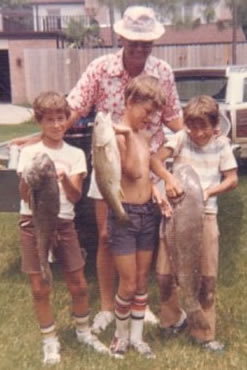
Since black drum are bottom feeders, people usually catch them with bait placed on or near the bottom. This works well for fishing from the shore or from a boat.
Shrimp is a great bait for black drum. Squid also works well and is less likely to be stolen by other fish. For older, larger black drum, a piece of blue crab (with the top shell removed) can be very effective. Sometimes, fishermen will also "chum" the water. This means scattering small pieces of fish or blood to attract the drum. Occasionally, black drum are caught using artificial lures like spoons and jigs.
When a black drum bites, it might just mouth the bait for a few seconds. Anglers need to wait a bit before pulling the hook. Once a big drum takes the bait, it can pull very hard! If your fishing rod isn't held tightly, it could easily be pulled into the water. Landing these big fish can be a real challenge, especially with lighter fishing gear. Since drum find food mostly by smell, using stronger fishing line won't scare them away. A 40-pound braided line with a strong leader is a good choice.
If you're fishing from a boat, look for a sandy bottom or an oyster bed where there's plenty of food. It's also good to fish when the tide is moving. If you're fishing from a pier or the bank, try near jetties, structures, or boat channels where the water gets deep quickly.
Black drum over 10 pounds are fairly easy for kids to catch if they have strong fishing gear. This is because black drum aren't easily scared and usually stay on the hook once they bite. However, big drum can make a long, powerful run right after they take the bait. So, it's important to set your reel's drag (which controls how much line comes out) a bit loose at the start of the fight to prevent the line from breaking.
Some states, like Texas, allow spearfishing for black drum. These fish often hang out near jetties and other structures close to shore.
Black Drum as Food
Black drum are edible and have a mild flavor. They are not very oily. Some restaurants in the southern United States serve smaller black drum.
Cleaning large black drum can be tricky because their scales are big and tough. Many fishermen use an electric knife to remove the fillets (the meat) from the fish. Fish over 15 pounds can be tough, almost like chicken, instead of having the flaky texture of many other fish. Younger black drum often taste very similar to red drum.
- Black Drum, Texas Parks and Wildlife, tpwd.state.tx.us
- Smithsonian Marine Station sms.si.edu
See also
 In Spanish: Corvina negra para niños
In Spanish: Corvina negra para niños



